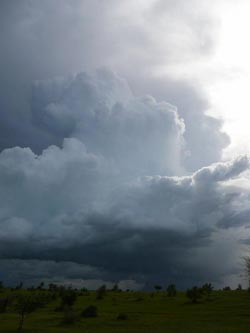Summer Rain More Likely over Drier Soils

A storm is brewing (Mali, Sahel)<br><br>"F. Guichard & L. Kergoat, AMMA project, CNRS" copyright<br>
Summer rain is more likely over drier soil – this is the conclusion scientists have drawn from a detailed analysis of satellite data. State-of-the-art computer models predict the opposite effect; these models must now be reconsidered, says the study published in the journal “Nature”.
Several international research groups were involved in the project: The Centre for Ecology and Hydrology (Wallingford, UK), the VU University Amsterdam, the Center of Meteorology CNRM in Toulouse, and the Vienna University of Technology.
Convective Showers: Hot Air Moves Up
Frontal rain systems, moving from the ocean across the land, can lead to rain over large areas. Summer showers, which frequently occur at the end of a hot day, are often restricted to a rather small region. This kind of rain is a completely different phenomenon. Instead of moving across the land, the air moves from the hot ground upwards, forming clouds high up in the air, and finally leading to rain. This is called “convective precipitation”.
Does Soil Moisture Lead to More Rain?
“It’s tempting to assume that moist soils lead to higher evaporation, which in turn stimulates more precipitation”, says Wouter Dorigo (Vienna University of Technology), one of the authors of the study. “This would imply that there is a positive feedback loop: moist soils lead to even more rain, whereas dry regions tend to remain dry.” But observations suggest otherwise: “We have analyzed data from different satellites measuring soil moisture and precipitation all over the globe, with a resolution of 50 to 100 kilometers. These data show that convective precipitation is more likely over drier soils”, says Wouter Dorigo.
The new data contradicts established computer models. A conclusive explanation for this effect has yet to be found. “The air over dry soils heats up more easily. This could lead to a more intense vertical draft”, Dorigo suspects. However, this cannot yet be described at a sufficient level of detail with today’s computer simulations.
Microwaves from Space
Soil moisture can be measured with satellites using microwave radiation. Unlike visible light, microwaves can penetrate clouds. Satellites can either measure the Earth's natural microwave radiation to calculate the local soil moisture (passive measurement) or the satellite sends out microwave pulses and measures how strongly the pulse is reflected by the surface (active measurement). From this data, the soil moisture can be calculated.
Picture Download:
http://www.tuwien.ac.at/dle/pr/aktuelles/downloads/2012/sommerregen/
Further information:
Dr. Wouter Dorigo
Institute for Photogrammetry and Remote Sensing
Vienna University of Technology
Gusshausstraße 25-29, 1040 Wien
T: +43-1-58801-12243
Mobile: +43-650-7426622
wouter.dorigo@tuwien.ac.at
Media Contact
More Information:
http://www.tuwien.ac.atAll latest news from the category: Earth Sciences
Earth Sciences (also referred to as Geosciences), which deals with basic issues surrounding our planet, plays a vital role in the area of energy and raw materials supply.
Earth Sciences comprises subjects such as geology, geography, geological informatics, paleontology, mineralogy, petrography, crystallography, geophysics, geodesy, glaciology, cartography, photogrammetry, meteorology and seismology, early-warning systems, earthquake research and polar research.
Newest articles

Future AR/VR controllers could be the palm of your hand
Carnegie Mellon University’s EgoTouch creates simple interfaces for virtual and augmented reality. The new generation of augmented and virtual reality controllers may not just fit in the palm of your…

‘Game changer’ in lithium extraction
Rice researchers develop novel electrochemical reactor. A team of Rice University researchers led by Lisa Biswal and Haotian Wang has developed an innovative electrochemical reactor to extract lithium from natural…

The blue-green sustainable proteins of seaweed
… may soon be on your plate. The protein in sea lettuce, a type of seaweed, is a promising complement to both meat and other current alternative protein sources. Seaweed…



